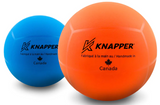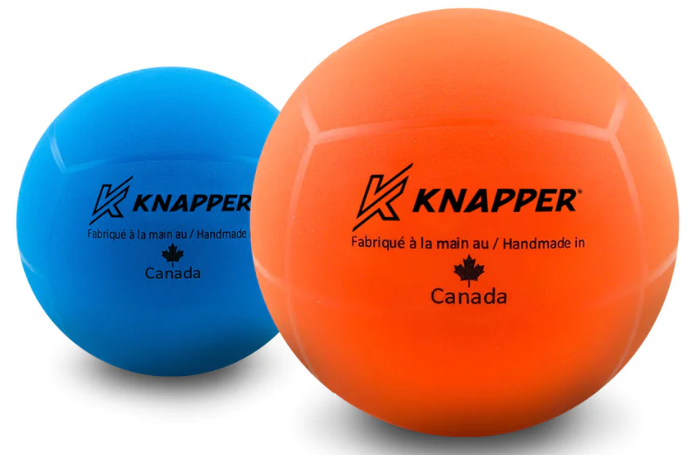Let's talk broomballs. The D-gel, Acacia and B2 orange indoor balls are very similar in construction, size and quality. All of these balls play well indoors. You may want to check with your league or tournament to see which broomball they recommend. The Blue Ox Practice ball is much harder out of the box than any of the other orange indoor broomballs. The D-Gel and Acacia blue rubber outdoor balls are also very similiar in constructions, size and quality. The basic difference between the outdoor and indoor rubber broomballs is that the blue balls are designed with a latex that will be softer in cold weather. That being said, not that much softer. I do not suggest using the outdoor rubber balls below temperatures of 20 degrees Fahrenheit. Below 20 degrees Fahrenheit all rubber balls freeze and will break at anytime. I suggest an orange hand stitched broomball for temperatures below 20 degrees Fahrenheit.
What is the proper inflation of a rubber broomball? You should inflate the ball to the point that when you bounce it hard on the ground, the ball should rebound no higher than about 3-4 feet. If you stand 10 feet away from the boards and throw the ball against the boards, ideally the ball will only bounce one time off of the boards. Make sure you do not over-inflate. An over-inflated indoor ball is difficult to control on the ice.
For recreational play, I recommend the orange hand stitched balls for indoor use as well. The hand stitched balls are a downsized soccer ball. They do bounce more than a rubber broomball, but the advantage on a recreational level is that they normally do not hurt as bad if you are hit by one. In general you will have less injuries using the orange hand stitched broomball. The other advantage is that they hold up better in cold temperatures. The blue hand stitched broomball is less expensive and the difference is the cover is made with more of a rubber material and they bounce more than the orange.
Inflation of a hand stitched ball is very important. They need to stay properly inflated. If the hand stitched balls lose air, the bladder inside will spin and the ball will be shot. I suggest inflating to a point where you can still push your thumb into the ball. Firm inflation, but not so firm as to stress the seams of the broomball. The firmer the ball the more it will bounce which can make the ball difficult to control on the ice.
Finally, the manufactures do not warranty broomballs. I hope the information above helps you make the right choice as well as maintain them during their difficult and brutal lives.



